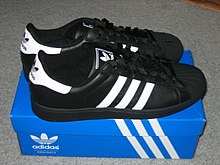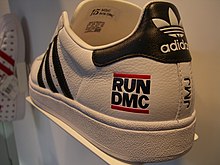Adidas Superstar: Difference between revisions
Tag: Removal of interwiki link; Wikidata is live |
m r2.7.2) (Robot: Adding de, id, no, ru, sv |
||
| Line 21: | Line 21: | ||
==References== |
==References== |
||
{{reflist}} |
{{reflist}} |
||
[[de:Adidas Superstar]] |
|||
[[id:Adidas Superstar]] |
|||
[[no:Adidas Superstar]] |
|||
[[ru:Adidas Superstar]] |
|||
[[sv:Adidas Superstar]] |
|||
Revision as of 18:22, 11 February 2013

The Superstar is a basketball shoe manufactured by athletic goods company Adidas since 1969, and it was released as a low top version of the Pro Model basketball shoe.[1] Nicknamed the "shelltoe", "shell shoes", and "shell tops" for their rubber shell toe piece, their iconic design is known as one of the major influences in the sneaker culture. They were voted best shoe ever on a radio poll in NY in 2011.
History
When the shoe was introduced, it was the first low-top basketball shoe to feature an all-leather upper and the now famous rubber shelltoe. With its rubber toe protection and non-marking sole, the shoe caught the attention of some of the best players from the NCAA and NBA, most notably Kareem Abdul Jabbar. Within the first few years of its introduction, the Superstar was being worn by over 75% of all NBA players; proof of its revolutionary technology which remains relevant today.[2] Over the course of the next few years, it would advance from the court to the sidewalk and, consequently, further into the public's consciousness.
In 1983, from Hollis Queens, NY, came Run-D.M.C., a rap group that refused to conform to pop standards by deciding that they would dress on stage the way they dressed on the streets. The trio was most notable for wearing the Superstars without any laces and pushing the tongue of the shoe out, imitating the fashion inside a prison. The Superstar received a lot of promotion from the rap group as they went out on tours across the US, increasing adidas' sales on the Superstar shoe. Responding to an anti-sneaker rap song by Jerrald Deas called "Felon Sneakers", the trio released a song of their own called "My Adidas" in 1986.[3] The song paid tribute to the Superstar shoe, and attempted to flip the stereotype of the 'b-boy'. Many years later, Adidas eventually signed an advertising deal with the group for 1 million dollars after realising how much promotion their product received from the trio. The deal made between Run-D.M.C. and Adidas was the first endorsement deal between hip-hop artists and a major corporation, and a Run-D.M.C. endorsed line of clothing from Adidas was subsequently released.[3]
The Superstar shoe has become part of popular youth fashion culture and are now worn regularly as casual footwear, rather than for sports. The Superstars, like the Converse Chuck Taylor All-Stars, easily made the transition from the basketball court to street as it was sported by hip-hop aficionados. In the late 1980s, 'b-boys' wore the shoes with extra thick laces called "fat laces", usually matching the color of the laces with the color of the three stripes on their shoe.
The Superstars (now known officially as the "Superstar II" as the current production shape differs from the original) are now being sold in Adidas Originals stores, with brand new colorways and designs as a fashion shoe with themes such as NBA teams or major US cities.
35th Anniversary Series
In 2005, Adidas celebrated the 35th anniversary of the Superstar by collaborating with icons from the world of music, fashion and arts to create the Adidas 35th Anniversary collection.[4]

References
- ^ "adidas Superstar". Sneakerfiles. Archived from the original on 23 October 2008. Retrieved 2008-10-17.
{{cite web}}: Unknown parameter|deadurl=ignored (|url-status=suggested) (help) - ^ "adidas kicks off Superstar Celebration". adidas press room. 2004-11-03. Retrieved 2008-10-17.
- ^ a b "Run-D.M.C." Britanica Encyclopedia. Archived from the original on 15 October 2008. Retrieved 2008-10-17.
{{cite web}}: Unknown parameter|deadurl=ignored (|url-status=suggested) (help) - ^ "3 stripes, 5 series, 35 models". adidas press room. 2005-02-03. Retrieved 2008-10-16.
